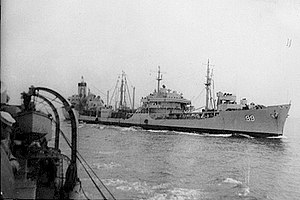USS Canisteo (AO-99)

USS Canisteo (AO-99) in the Mediterranean, 1951
|
|
| History | |
|---|---|
|
|
|
| Name: | USS Canisteo |
| Namesake: | The Canisteo River in New York |
| Ordered: | as T3-S2-A1 tanker hull, MC hull 2561 |
| Laid down: | 11 November 1944 |
| Launched: | 6 July 1945 |
| Commissioned: | 3 December 1945 |
| Decommissioned: | 2 October 1989 |
| Struck: | 31 August 1992 |
| Fate: | Sold for scrap to Able UK and towed to Hartlepool UK, 2003. Scrapping complete, August 2010. |
| General characteristics | |
| Class and type: | Cimarron-class oiler |
| Displacement: |
|
| Length: |
|
| Beam: | 75 ft (23 m) |
| Draught: | 32 ft (9.8 m) |
| Propulsion: | steam turbines, four boilers, two shafts, 13,500 shp (10,100 kW) , twin screws, 30,400 hp (22,700 kW) |
| Speed: | 18 knots (33 km/h) |
| Capacity: | 146,000 barrels (23,200 m3) |
| Complement: | 22 officers, 362 enlisted |
| Armament: |
|
USS Canisteo (AO-99) was a Cimarron-class fleet oiler constructed for the U.S. Navy in the closing days of World War II. Commissioned too late for service in that conflict, she had a lengthy career in the Cold War that followed. She was the only U.S. Navy ship to bear the name Canisteo, after the Canisteo River in New York.
Canisteo (AO-99) was launched 6 July 1945 by Bethlehem Steel-Sparrows Point Shipyard, Inc., Sparrows Point, Maryland, under a Maritime Commission contract; sponsored by Mrs. J. N. Chambers; and commissioned 3 December 1945, Lieutenant Commander E. L. Denton, USNR, in command.
Canisteo cleared Norfolk 4 February 1946 for Melville, Rhode Island, where she loaded diesel oil for naval units taking part in the occupation of Germany. Returning from Bremerhaven and Farge, Germany, she carried out training operations in the Caribbean, and then sailed to Iceland and Greenland, returning to New York City 27 May.
The tanker sailed south from Norfolk 27 November 1946 as a unit of Operation Highjump, the largest Antarctic expedition to that time. Steaming through the Panama Canal to the Antarctic, Canisteo reached Scott and Peter Islands and provided critical logistic support for this historic exploratory and scientific project, carrying on the Navy's traditional role in expanding man's frontiers. Canisteo returned to Norfolk 23 April 1947 after calling at Rio de Janeiro and Caribbean ports.
...
Wikipedia
